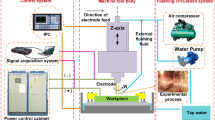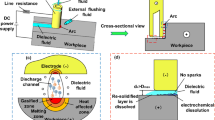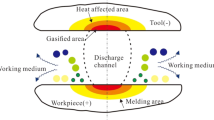Abstract
Short electric arc–electrochemical combined machining (SEAECM) involves both short electric arc discharge and electrochemical dissolution processes, and the choice of electrode materials has an important impact on the respective machining performance of short electric arc machining (SEAM) and electrochemical machining (ECM). Therefore, this research compares the performance of three commonly used low-cost materials (brass, copper, and graphite) as electrodes in SEAECM. The effects of different process parameters (voltage, duty ratio, electrolyte concentration, and feedrate) on the material removal rate, electrode volume wear, surface roughness, and dimensional accuracy errors of the three electrodes in SEAECM are also investigated to determine the applicable occasions for different electrode materials. The results show that the physical properties of the electrode materials such as resistivity, thermal conductivity, and melting point have a significant effect on the machining results. The brass electrode has the highest wear and the lowest material removal rate for all parameters. The copper electrode has the most balanced machining performance, especially at low discharge energy, with low electrode wear and good surface quality. Graphite electrode shows machining potential at high discharge energy, but still requires coordination of SEAM and ECM to improve the surface quality. Overall, in SEAECM, the copper electrode is suitable for high surface quality machining at low discharge energy, and the graphite electrode is suitable for efficient and medium quality machining at higher discharge energy.

















Similar content being viewed by others
Availability of data and material
All data generated or analyzed during this study are included in this published article.
Code availability
Software application or custom code.
References
Guo YB, Li W, Jawahir IS (2009) Surface integrity characterization and prediction in machining of hardened and difficult-to-machine alloys: a state-of-art research review and analysis. Mach Sci Technol 13:437–470. https://doi.org/10.1080/10910340903454922
Huang PL, Li JF, Sun J, Jia XM (2016) Cutting signals analysis in milling titanium alloy thin-part components and non-thin-wall components. Int J Adv Manuf Technol 84:2461–2469. https://doi.org/10.1007/s00170-015-7837-0
Pervaiz S, Rashid A, Deiab I, Nicolescu M (2014) Influence of tool materials on machinability of titanium- and nickel-based alloys: a review. Mater Manuf Process 29:219–252. https://doi.org/10.1080/10426914.2014.880460
Zhang D (2001) Fundamentals of application of materials in mechanical engineering. China Machine Press, Beijing
Abbas NM, Solomon DG, Bahari MF (2007) A review on current research trends in electrical discharge machining (EDM). Int J Mach Tools Manuf. https://doi.org/10.1016/j.ijmachtools.2006.08.026
Xu Z, Wang Y (2021) Electrochemical machining of complex components of aero-engines: developments, trends, and technological advances. Chin J Aeronaut 34:28–53. https://doi.org/10.1016/j.cja.2019.09.016
Philip JT, Mathew J, Kuriachen B (2020) Numerical simulation of the effect of crater morphology for the prediction of surface roughness on electrical discharge textured Ti6Al4V. J Braz Soc Mech Sci Eng 42:1–18. https://doi.org/10.1007/s40430-020-02321-6
Pramanik A, Basak AK, Prakash C et al (2021) Recast layer formation during wire electrical discharge machining of titanium (Ti–Al6–V4) Alloy. J Mater Eng Perform 30:8926–8935. https://doi.org/10.1007/s11665-021-06116-1
Sawicki J, Paczkowski T (2015) Effect of the hydrodynamic conditions of electrolyte flow on critical states in electrochemical machining. EPJ Web Conf 92:2–6. https://doi.org/10.1051/epjconf/20159202078
Nguyen MD, Rahman M, Wong YS (2012) Simultaneous micro-EDM and micro-ECM in low-resistivity deionized water. Int J Mach Tools Manuf 54–55:55–65. https://doi.org/10.1016/j.ijmachtools.2011.11.005
Zhang Y, Xu Z, Zhu D et al (2016) Drilling of film cooling holes by a EDM/ECM in situ combined process using internal and side flushing of tubular electrode. Int J Adv Manuf Technol 83:505–517. https://doi.org/10.1007/s00170-015-7575-3
Li C, Zhang B, Li Y et al (2018) Self-adjusting EDM/ECM high speed drilling of film cooling holes. J Mater Process Technol 262:95–103. https://doi.org/10.1016/j.jmatprotec.2018.06.026
Han Y, Liu Z, Qiu M et al (2021) Combined milling of electrical discharge ablation machining and electrochemical machining. Int J Adv Manuf Technol 112:2889–2897. https://doi.org/10.1007/s00170-020-06300-y
Zhao W, Gu L, Xu H et al (2013) A novel high efficiency electrical erosion process-blasting erosion arc machining. Procedia CIRP 6:621–625. https://doi.org/10.1016/j.procir.2013.03.057
Shen Y, Liu Y, Zhang Y et al (2016) Effects of an electrode material on a novel compound machining of Inconel718. Mater Manuf Process 31:845–851. https://doi.org/10.1080/10426914.2015.1019133
Zhou JP, Liang CH, Teng WJ et al (2008) Study on rules in material removal rate and surface quality of short electric arc machining process. Adv Mater Res 33–37:1313–1318. https://doi.org/10.4028/www.scientific.net/AMR.33-37.1313
Kou Z, Han F, Wang G (2019) Research on machining Ti6Al4V by high-speed electric arc milling with breaking arcs via mechanical-hydrodynamic coupling forces. J Mater Process Technol 271:499–509. https://doi.org/10.1016/j.jmatprotec.2019.04.021
Czelusniak T, Higa CF, Torres RD et al (2019) Materials used for sinking EDM electrodes: a review. J Braz Soc Mech Sci Eng 41:1–25. https://doi.org/10.1007/s40430-018-1520-y
Kunieda M, Lauwers B, Rajurkar KP, Schumacher BM (2005) Advancing EDM through fundamental insight into the process. CIRP Ann-Manuf Technol 54:64–87. https://doi.org/10.1016/s0007-8506(07)60020-1
Dewangan S, Biswas CK, Gangopadhyay S (2014) Influence of different tool electrode materials on EDMed surface integrity of AISI P20 tool steel. Mater Manuf Process 29:1387–1394. https://doi.org/10.1080/10426914.2014.930892
Pilligrin JC, Asokan P, Jerald J, Kanagaraj G (2018) Effects of electrode materials on performance measures of electrical discharge micro-machining. Mater Manuf Process 33:606–615. https://doi.org/10.1080/10426914.2017.1364757
Ahmed A, Tanjilul M, Rahman M, Kumar AS (2020) Ultrafast drilling of Inconel 718 using hybrid EDM with different electrode materials. Int J Adv Manuf Technol 106:2281–2294. https://doi.org/10.1007/s00170-019-04769-w
Yue X, Yang X (2021) The role of discharge plasma on molten pool dynamics in EDM. J Mater Process Technol 293:117092. https://doi.org/10.1016/j.jmatprotec.2021.117092
Kurita T, Hattori M (2006) A study of EDM and ECM/ECM-lapping complex machining technology. Int J Mach Tools Manuf 46:1804–1810. https://doi.org/10.1016/j.ijmachtools.2005.11.009
Nguyen MD, Rahman M, Wong YS (2013) Transitions of micro-EDM/SEDCM/micro-ECM milling in low-resistivity deionized water. Int J Mach Tools Manuf 69:48–56. https://doi.org/10.1016/j.ijmachtools.2013.03.008
Natsu W, Ikeda T, Kunieda M (2007) Generating complicated surface with electrolyte jet machining. Precis Eng 31:33–39. https://doi.org/10.1016/j.precisioneng.2006.02.004
Dai X, Wen C, Wu L et al (2021) Influences of pulse frequency on formation and properties of composite anodic oxide films on Ti–10V–2Fe–3Al alloy. Chin J Aeronaut 34:228–242. https://doi.org/10.1016/j.cja.2021.02.001
Liu JF, Guo YB, Butler TM, Weaver ML (2016) Crystallography, compositions, and properties of white layer by wire electrical discharge machining of nitinol shape memory alloy. Mater Des 109:1–9. https://doi.org/10.1016/j.matdes.2016.07.063
Speidel A, Mitchell-Smith J, Walsh DA et al (2016) Electrolyte Jet machining of titanium alloys using novel electrolyte solutions. Procedia CIRP 42:367–372. https://doi.org/10.1016/j.procir.2016.02.200
Funding
This research was supported by the Tianshan Innovation Team Project (Grant No. 2022D14002) and the Natural Science Foundation of China (Grant No. 51765063).
Author information
Authors and Affiliations
Contributions
All authors contributed to the study conception and design. Material preparation, data collection and analysis were performed by SZ, GH, JZ, LW, YX, XD, JW, XM. The first draft of the manuscript was written by SZ, and all authors commented on previous versions of the manuscript. All authors read and approved the final manuscript.
Corresponding authors
Ethics declarations
Conflict of interest
The authors declare that they have no conflict of interest. The authors declare that they have no known competing financial interests or personal relationships that could have appeared to influence the work reported in this paper.
Additional information
Technical Editor: Adriano Fagali de Souza.
Publisher's Note
Springer Nature remains neutral with regard to jurisdictional claims in published maps and institutional affiliations.
Rights and permissions
Springer Nature or its licensor holds exclusive rights to this article under a publishing agreement with the author(s) or other rightsholder(s); author self-archiving of the accepted manuscript version of this article is solely governed by the terms of such publishing agreement and applicable law.
About this article
Cite this article
Zhang, S., Hu, G., Zhou, J. et al. Research on short electric arc–electrochemical combined machining performance of Ti–6Al–4V alloys using different electrode materials. J Braz. Soc. Mech. Sci. Eng. 44, 463 (2022). https://doi.org/10.1007/s40430-022-03766-7
Received:
Accepted:
Published:
DOI: https://doi.org/10.1007/s40430-022-03766-7




